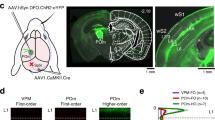Abstract.
Neurons in layer IV of rat somatosensory (SI) barrel cortex receive punctate somatic input from well-defined regions of the periphery. Following peripheral deafferentation, SI neurons in deafferented cortex respond to new input from neighboring regions of the skin surface. The precise mechanism(s) through which this occurs is unknown, although corticocortical and barreloid to barrel connections have been suggested as possible substrates. Because layer-IV barrels receive a strong afferent input from ventroposterior (VP) thalamic projection neurons, any divergence in the thalamocortical (TC) projection to multiple cortical barrels could also provide an anatomical substrate for rapid cortical reorganization. We used in-vivo intracellular recording methods to record and physiologically identify neurons in rat VP and to label those neurons with an intracellular tracer. Thalamic neurons (n=117) were impaled with sharp intracellular electrodes, and the receptive field(s) and firing pattern were measured. Cells were then injected with biocytin or biotinylated dextran amine (BDA). A total of 38 labeled TC neurons were quantitatively analyzed for soma size and dendritic arborization size; quantitative analysis of TC-axon arborizations in layer IV of barrel cortex was carried out in a total of 13 TC neurons. Two different axon-arborization patterns were identified in SI cortex: direct-projecting axons (n=6) were observed to project to and arborize within a single cortical barrel as well as extend their fibers into adjacent barrels; bifurcating-type axons (n=7) were seen to bifurcate in the subcortical white matter or in layer VI and then project to multiple barrel columns, where they arborized in layer IV. Axon fibers were always observed in three or more cortical barrels (mean=5, range=3–7). The mean mediolateral extent of arborizations in layer IV for the direct-projecting and bifurcating type axons were 458 µm and 1302 µm, respectively, and these were significantly different (t=3.78, P<0.01). Axon-fiber length within cortical laminae was measured for each arborization pattern in relationship to the total fiber length within a cortical column. Direct-projecting axons always had greater than 50% of their fiber length within layer IV. Bifurcating-type axons were differentially distributed within multiple columns and always had less than 50% of their total column fiber length in layer IV. Morphological analysis of TC somata and dendrites revealed no correlation between local neuron morphology and axonal-arborization patterns. All intracellularly recorded TC neurons had similar adapting firing patterns when injected with a long-duration pulse. Our results showed that TC neurons project to multiple cortical barrels with one barrel receiving the principal input. This divergent TC projection pattern in SI cortex may provide an anatomical substrate for cortical plasticity and must be considered in any mechanism of rapid cortical reorganization.
Similar content being viewed by others
Author information
Authors and Affiliations
Additional information
Electronic Publication
Rights and permissions
About this article
Cite this article
Arnold, P., Li, C. & Waters, R. Thalamocortical arbors extend beyond single cortical barrels: an in vivo intracellular tracing study in rat. Exp Brain Res 136, 152–168 (2001). https://doi.org/10.1007/s002210000570
Received:
Accepted:
Issue Date:
DOI: https://doi.org/10.1007/s002210000570




